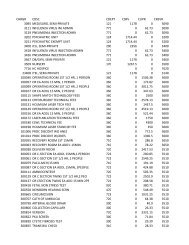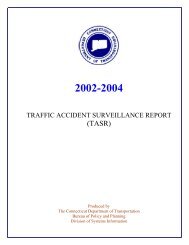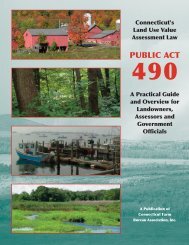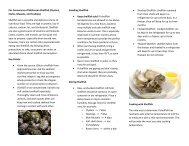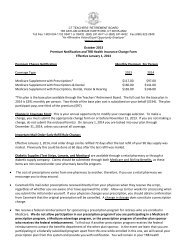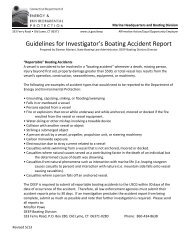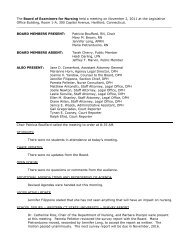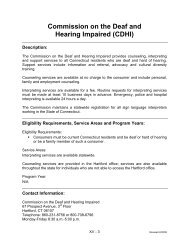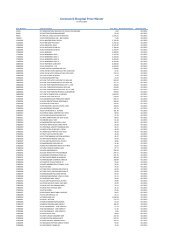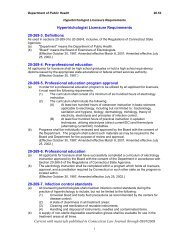2013 CT Anglers Guide - CT.gov
2013 CT Anglers Guide - CT.gov
2013 CT Anglers Guide - CT.gov
You also want an ePaper? Increase the reach of your titles
YUMPU automatically turns print PDFs into web optimized ePapers that Google loves.
Marine Angler Surveys<br />
<strong>CT</strong> DEEP MARINE ANGLER SURVEY<br />
The Marine Recreational Information Program<br />
(MRIP) is a nation-wide program by the National<br />
Marine Fisheries Service (NMFS) to establish a<br />
reliable database for estimating the impact of<br />
recreational fishing on saltwater fish resources.<br />
This survey is conducted in all U.S. coastal states.<br />
The information is used by Fishery Management<br />
Councils, the Atlantic States Marine Fisheries<br />
Commission (ASMFC), as well as Federal<br />
and State resource agencies to create fishery<br />
management plans and to evaluate the impact<br />
of fishing regulations.<br />
Estimates generated from the MRIP include the:<br />
• total number of fish caught, released and<br />
harvested;<br />
• weight of the harvest;<br />
• total number of angler trips;<br />
• number of marine recreational anglers.<br />
Survey questions include: where you were<br />
fishing; how long you were fishing; what species<br />
you were fishing for; how many did you catch<br />
and release; can we measure and weigh your<br />
kept fish; what town do you live in; how often<br />
do you fish, your name and phone number.<br />
MARINE VOLUNTEER ANGLER<br />
SURVEY PROGRAM<br />
The Marine Fisheries Division is seeking marine<br />
recreational anglers who will volunteer to participate<br />
in the Connecticut Volunteer Angler<br />
Survey (VAS) Program. The VAS Program<br />
is designed to collect fishing trip and catch<br />
information from marine recreational (hook<br />
and line) anglers who volunteer to record their<br />
angling activities via a logbook. VAS anglers<br />
BLACK SEA BASS<br />
INTERESTING FA<strong>CT</strong>S<br />
Black sea bass occurs along the Atlantic Coast<br />
of the United States from Cape Cod to Florida.<br />
Black sea bass has an unusual life cycle: they are<br />
protogynous hermaphrodites, which mean they<br />
start life as a female and when they reach 9–13<br />
inches they change sex to become males initiated<br />
by visual cues. Most sea bass are born females.<br />
Although some fish are males from the time they<br />
reach sexual maturity, most produce eggs when<br />
they first mature. The age at which individuals<br />
"switch" from female to male is variable, although<br />
most fish have done so before they are 6 years old.<br />
In heavily exploited populations in which larger,<br />
older males are selectively harvested, the resulting<br />
death of males causes females to change sex at<br />
a younger age and smaller size than would be<br />
the case in populations less depleted by fishing.<br />
Black sea bass generally overwinter offshore<br />
in deeper water on the continental shelf to 100<br />
fathoms. In the spring, this species displays<br />
a general northward and inshore movement,<br />
expanding its range as far north as Cape Cod from<br />
May to October. During the summer, adult sea bass<br />
contribute valuable fisheries-specific information<br />
concerning striped bass, fluke, bluefish, scup,<br />
tautog and other important finfish species used<br />
in monitoring and assessing fish populations<br />
inhabiting marine waters.<br />
* New for <strong>2013</strong>, participants will have the choice<br />
of either filling out the traditional paper logbooks<br />
and mailing them back in or by entering their<br />
data electronically by a computer web based<br />
application. In either case, paper logbooks will<br />
still be sent out to each angler.<br />
Both the VAS paper logbook and the computer<br />
electronic version are easy to enter. Each participating<br />
angler is assigned a personal code number<br />
for confidentiality. The paper logbook instructions<br />
are located on the inside cover and the<br />
electronic version will have a specified menu<br />
with assisted help information. Upon completion<br />
of the paper logbook, tape the pre-postage<br />
paid logbook shut and drop it off in the mail.<br />
All paper logbooks are returned to each angler<br />
for their own personal records upon data entry.<br />
<strong>Anglers</strong> that participate are also provided<br />
with updated program results and public<br />
hearing notices concerning recreational fishery<br />
management regulations.<br />
Participating is very important for marine fisheries<br />
management. Please contact:<br />
Rod MacLeod<br />
rod.macleod@ct.<strong>gov</strong><br />
860-434-6043<br />
<strong>CT</strong> Department of Energy<br />
& Environmental Protection<br />
Marine Fisheries Division<br />
P.O. Box 719, Old Lyme, <strong>CT</strong> 06371<br />
Holly Sulzinski with her<br />
youth state record<br />
black sea bass.<br />
gather around<br />
rocky bottoms,<br />
sunken wrecks,<br />
old pilings, and<br />
wharves. At this<br />
time of year,<br />
they are most<br />
abundant at depths of less than 120 feet. Youngof-the-year<br />
and yearlings tend to summer in<br />
estuaries, which are critically important nursery<br />
grounds for this species.<br />
Black sea bass reproduce from February to July,<br />
with the spawning season starting earliest in the<br />
southern portion of their range and progressing<br />
northward as spring passes. Off the southern New<br />
England coast, they reproduce from mid-May until<br />
the end of June. The eggs are buoyant, floating in<br />
the water column until they hatch 1½ to 5 days<br />
after fertilization. The larvae drift in bays, inlets,<br />
and offshore areas; they become bottom-dwelling<br />
when they have grown to about ½ inch in length.<br />
The largest black sea bass caught by an angler in<br />
Connecticut's waters weighed 7 pounds 8 ounces<br />
(Six-Mile Reef, Clinton). A 12-inch fish generally<br />
weighs 1 pound, while an 18 to 20-inch fish weighs<br />
about 3 pounds. Females mature at 2–4 years of<br />
age. Approximate size at maturity is 7 to 8 inches.<br />
Marcelo Moutinho and family<br />
with his state record scup<br />
4 lbs. 2 oz., 19 inches.<br />
Fishing in Connecticut,<br />
Share the Experience…<br />
Take the Family or a Friend Fishing<br />
Fred Spadaccini and son<br />
with their striped bass<br />
caught during the Bonus<br />
Striped Bass Fishing<br />
Program (see page 8<br />
for more information).<br />
Try Saltwater Fishing<br />
in Long Island Sound<br />
You will be glad you did!<br />
46 deep.marine.fisheries@ct.<strong>gov</strong><br />
<strong>2013</strong> Connecticut Angler’s <strong>Guide</strong>




